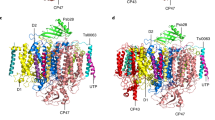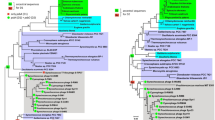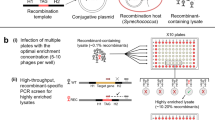Abstract
Cyanophage genomes frequently possess the psbA gene, encoding the D1 polypeptide of photosystem II. This protein is believed to maintain host photosynthetic capacity during infection and enhance phage fitness under high-light conditions. Although the first documented cyanophage-encoded psbA gene contained a group I intron, this feature has not been widely reported since, despite a plethora of new sequences becoming available. In this study, we show that in cyanophage S-PM2, this intron is spliced during the entire infection cycle. Furthermore, we report the widespread occurrence of psbA introns in marine metagenomic libraries, and with psbA often adjacent to a homing endonuclease (HE). Bioinformatic analysis of the intergenic region between psbA and the adjacent HE gene F-CphI in S-PM2 showed the presence of an antisense RNA (asRNA) connecting these two separate genetic elements. The asRNA is co-regulated with psbA and F-CphI, suggesting its involvement with their expression. Analysis of scaffolds from global ocean survey datasets shows this asRNA to be commonly associated with the 3′ end of cyanophage psbA genes, implying that this potential mechanism of regulating marine ‘viral’ photosynthesis is evolutionarily conserved. Although antisense transcription is commonly found in eukaryotic and increasingly also in prokaryotic organisms, there has been no indication for asRNAs in lytic phages so far. We propose that this asRNA also provides a means of preventing the formation of mobile group I introns within cyanophage psbA genes.
Similar content being viewed by others
Log in or create a free account to read this content
Gain free access to this article, as well as selected content from this journal and more on nature.com
or
Accession codes
References
Backofen R, Hess WR . (2010). Computational prediction of sRNAs and their targets in bacteria. RNA Biol 7: 1–10.
Bonocora RP, Shub DA . (2009). A likely pathway for formation of mobile group I introns. Curr Biol 19: 223–228.
Bragg JG, Chisholm SW . (2008). Modeling the fitness consequences of a cyanophage-encoded photosynthesis gene. PLoS One 3: e3550.
Brantl S . (2007). Regulatory mechanisms employed by cis-encoded antisense RNAs. Curr Opin Microbiol 10: 102–109.
Brouard JS, Otis C, Lemieux C, Turmel M . (2008). Chloroplast DNA sequence of the green alga Oedogonium cardiacum (Chlorophyceae): unique genome architecture, derived characters shared with the Chaetophorales and novel genes acquired through horizontal transfer. BMC Genomics 9: 290.
Chenard C, Suttle CA . (2008). Phylogenetic diversity of sequences of cyanophage photosynthetic gene psbA in marine and freshwaters. Appl Environ Microbiol 74: 5317–5324.
Clokie MR, Shan J, Bailey S, Jia Y, Krisch HM, West S et al. (2006). Transcription of a ‘photosynthetic’ T4-type phage during infection of a marine cyanobacterium. Environ Microbiol 8: 827–835.
Deshpande NN, Bao Y, Herrin DL . (1997). Evidence for light/redox-regulated splicing of psbA pre-RNAs in Chlamydomonas chloroplasts. RNA 3: 37–48.
Dufresne A, Ostrowski M, Scanlan DJ, Garczarek L, Mazard S, Palenik BP et al. (2008). Unraveling the genomic mosaic of a ubiquitous genus of marine cyanobacteria. Genome Biol 9: R90.
Duhring U, Axmann IM, Hess WR, Wilde A . (2006). An internal antisense RNA regulates expression of the photosynthesis gene isiA. Proc Natl Acad Sci USA 103: 7054–7058.
Georg J, Voss B, Scholz I, Mitschke J, Wilde A, Hess WR . (2009). Evidence for a major role of antisense RNAs in cyanobacterial gene regulation. Mol Syst Biol 5: 305.
Hellweger FL . (2009). Carrying photosynthesis genes increases ecological fitness of cyanophage in silico. Environ Microbiol 11: 1386–1394.
Hernandez JA, Muro-Pastor AM, Flores E, Bes MT, Peleato ML, Fillat MF . (2006). Identification of a furA cis antisense RNA in the cyanobacterium Anabaena sp. PCC 7120. J Mol Biol 355: 325–334.
Huelsenbeck JP, Ronquist F . (2001). MRBAYES: Bayesian inference of phylogenetic trees. Bioinformatics 17: 754–755.
Itoh T, Tomizawa J . (1980). Formation of an RNA primer for initiation of replication of ColE1 DNA by ribonuclease H. Proc Natl Acad Sci USA 77: 2450–2454.
Jurica MS, Stoddard BL . (1999). Homing endonucleases: structure, function and evolution. Cell Mol Life Sci 55: 1304–1326.
Kettler GC, Martiny AC, Huang K, Zucker J, Coleman ML, Rodrigue S et al. (2007). Patterns and implications of gene gain and loss in the evolution of Prochlorococcus. PLoS Genet 3: e231.
Krinke L, Wulff DL . (1987). OOP RNA, produced from multicopy plasmids, inhibits lambda cII gene expression through an RNase III-dependent mechanism. Genes Dev 1: 1005–1013.
Lacatena RM, Cesareni G . (1981). Base pairing of RNA I with its complementary sequence in the primer precursor inhibits ColE1 replication. Nature 294: 623–626.
Lee J, Herrin DL . (2003). Mutagenesis of a light-regulated psbA intron reveals the importance of efficient splicing for photosynthetic growth. Nucleic Acids Res 31: 4361–4372.
Lindell D, Jaffe JD, Coleman ML, Futschik ME, Axmann IM, Rector T et al. (2007). Genome-wide expression dynamics of a marine virus and host reveal features of co-evolution. Nature 449: 83–86.
Lindell D, Jaffe JD, Johnson ZI, Church GM, Chisholm SW . (2005). Photosynthesis genes in marine viruses yield proteins during host infection. Nature 438: 86–89.
Lindell D, Sullivan MB, Johnson ZI, Tolonen AC, Rohwer F, Chisholm SW . (2004). Transfer of photosynthesis genes to and from Prochlorococcus viruses. Proc Natl Acad Sci USA 101: 11013–11018.
Liu Q, Belle A, Shub DA, Belfort M, Edgell DR . (2003). SegG endonuclease promotes marker exclusion and mediates co-conversion from a distant cleavage site. J Mol Biol 334: 13–23.
Livak KJ, Schmittgen TD . (2001). Analysis of relative gene expression data using real-time quantitative PCR and the 2(-Delta Delta C(T)) method. Methods 25: 402–408.
Logemann J, Schell J, Willmitzer L . (1987). Improved method for the isolation of RNA from plant tissues. Anal Biochem 163: 16–20.
Lu J, Chen F, Hodson RE . (2001). Distribution, isolation, host specificity, and diversity of cyanophages infecting marine Synechococcus spp. in river estuaries. Appl Environ Microbiol 67: 3285–3290.
Mann NH, Clokie MR, Millard A, Cook A, Wilson WH, Wheatley PJ et al. (2005). The genome of S-PM2, a ‘photosynthetic’ T4-type bacteriophage that infects marine Synechococcus strains. J Bacteriol 187: 3188–3200.
Mann NH, Cook A, Millard A, Bailey S, Clokie M . (2003). Marine ecosystems: bacterial photosynthesis genes in a virus. Nature 424: 741.
Markham NR, Zuker M . (2008). UNAFold: software for nucleic acid folding and hybridization. In: Keith JM (ed). Bioinformatics Volume II. Structure, Functions and Applications. Humana Press: Totowa, NJ, USA, pp 3–31.
Marston MF, Amrich CG . (2009). Recombination and microdiversity in coastal marine cyanophages. Environ Microbiol 11: 2893–2903.
Marston MF, Sallee JL . (2003). Genetic diversity and temporal variation in the cyanophage community infecting marine Synechococcus species in Rhode Island's coastal waters. Appl Environ Microbiol 69: 4639–4647.
Maul JE, Lilly JW, Cui L, dePamphilis CW, Miller W, Harris EH et al. (2002). The Chlamydomonas reinhardtii plastid chromosome: islands of genes in a sea of repeats. Plant Cell 14: 2659–2679.
Millard A, Clokie MR, Shub DA, Mann NH . (2004). Genetic organization of the psbAD region in phages infecting marine Synechococcus strains. Proc Natl Acad Sci USA 101: 11007–11012.
Millard A, Mann NH . (2006). A temporal and spatial investigation of cyanophage abundance in the Gulf of Aqaba, Red Sea. J Mar Biol Assocn UK 86: 507–515.
Millard AD, Zwirglmaier K, Downey MJ, Mann NH, Scanlan DJ . (2009). Comparative genomics of marine cyanomyoviruses reveals the widespread occurrence of Synechococcus host genes localized to a hyperplastic region: implications for mechanisms of cyanophage evolution. Environ Microbiol 11: 2370–2387.
Raghavan R, Minnick MF . (2009). Group I introns and inteins: disparate origins but convergent parasitic strategies. J Bacteriol 191: 6193–6202.
Rusch DB, Halpern AL, Sutton G, Heidelberg KB, Williamson S, Yooseph S et al. (2007). The Sorcerer II Global Ocean Sampling expedition: Northwest Atlantic through eastern tropical Pacific. PLoS Biol 5: e77.
Scanlan DJ, Ostrowski M, Mazard S, Dufresne A, Garczarek L, Hess WR et al. (2009). Ecological genomics of marine picocyanobacteria. Microbiol Mol Biol Rev 73: 249–299.
Seshadri R, Kravitz SA, Smarr L, Gilna P, Frazier M . (2007). CAMERA: a community resource for metagenomics. PLoS Biol 5: e75.
Sharon I, Alperovitch A, Rohwer F, Haynes M, Glaser F, Atamna-Ismaeel N et al. (2009). Photosystem I gene cassettes are present in marine virus genomes. Nature 461: 258–262.
Sharon I, Tzahor S, Williamson S, Shmoish M, Man-Aharonovich D, Rusch DB et al. (2007). Viral photosynthetic reaction center genes and transcripts in the marine environment. ISME J 1: 492–501.
Simmonds P, Smith DB . (1999). Structural constraints on RNA virus evolution. J Virol 73: 5787–5794.
Spiegelman WG, Reichardt LF, Yaniv M, Heinemann SF, Kaiser AD, Eisen H . (1972). Bidirectional transcription and the regulation of Phage lambda repressor synthesis. Proc Natl Acad Sci USA 69: 3156–3160.
Steglich C, Futschik ME, Lindell D, Voss B, Chisholm SW, Hess WR . (2008). The challenge of regulation in a minimal photoautotroph: non-coding RNAs in Prochlorococcus. PLoS Genet 4: e1000173.
Stork M, Di Lorenzo M, Welch TJ, Crosa JH . (2007). Transcription termination within the iron transport-biosynthesis operon of Vibrio anguillarum requires an antisense RNA. J Bacteriol 189: 3479–3488.
Sullivan MB, Coleman ML, Weigele P, Rohwer F, Chisholm SW . (2005). Three Prochlorococcus cyanophage genomes: signature features and ecological interpretations. PLoS Biol 3: e144.
Sullivan MB, Krastins B, Hughes JL, Kelly L, Chase M, Sarracino D et al. (2009). The genome and structural proteome of an ocean siphovirus: a new window into the cyanobacterial ‘mobilome’. Environ Microbiol 11: 2935–2951.
Sullivan MB, Lindell D, Lee JA, Thompson LR, Bielawski JP, Chisholm SW . (2006). Prevalence and evolution of core photosystem II genes in marine cyanobacterial viruses and their hosts. PLoS Biol 4: e234.
Sullivan MB, Waterbury JB, Chisholm SW . (2003). Cyanophages infecting the oceanic cyanobacterium Prochlorococcus. Nature 424: 1047–1051.
Suttle CA . (2005). Viruses in the sea. Nature 437: 356–361.
Suttle CA . (2007). Marine viruses—major players in the global ecosystem. Nat Rev Microbiol 5: 801–812.
Suttle CA, Chan AM . (1994). Dynamics and distribution of cyanophages and their effect on marine Synechococcus spp. Appl Environ Microbiol 60: 3167–3174.
Tramonti A, De Canio M, De Biase D . (2008). GadX/GadW-dependent regulation of the Escherichia coli acid fitness island: transcriptional control at the gadY-gadW divergent promoters and identification of four novel 42 bp GadX/GadW-specific binding sites. Mol Microbiol 70: 965–982.
Wang K, Chen F . (2008). Prevalence of highly host-specific cyanophages in the estuarine environment. Environ Microbiol 10: 300–312.
Waterbury JB, Valois FW . (1993). Resistance to co-occurring phages enables marine Synechococcus communities to coexist with cyanophages abundant in seawater. Appl Environ Microbiol 59: 3393–3399.
Weigele PR, Pope WH, Pedulla ML, Houtz JM, Smith AL, Conway JF et al. (2007). Genomic and structural analysis of Syn9, a cyanophage infecting marine Prochlorococcus and Synechococcus. Environ Microbiol 9: 1675–1695.
Williamson SJ, Rusch DB, Yooseph S, Halpern AL, Heidelberg KB, Glass JI et al. (2008). The Sorcerer II Global ocean sampling expedition: metagenomic characterization of viruses within aquatic microbial samples. PLoS One 3: e1456.
Wilson WH, Carr NG, Mann NH . (1996). The effect of phosphate status on the kinetics of cyanophage infection in the oceanic cyanobacterium Synechococcus sp WH7803. J Phycol 32: 506–516.
Wilson WH, Joint IR, Carr NG, Mann NH . (1993). Isolation and molecular characterization of five marine cyanophages propagated on Synechococcus sp. Strain WH7803. Appl Environ Microbiol 59: 3736–3743.
Wyman M, Gregory RP, Carr NG . (1985). Novel role for phycoerythrin in a marine cyanobacterium, Synechococcus strain DC2. Science 230: 818–820.
Zeidner G, Bielawski JP, Shmoish M, Scanlan DJ, Sabehi G, Beja O . (2005). Potential photosynthesis gene recombination between Prochlorococcus and Synechococcus via viral intermediates. Environ Microbiol 7: 1505–1513.
Zeidner G, Preston CM, Delong EF, Massana R, Post AF, Scanlan DJ et al. (2003). Molecular diversity among marine picophytoplankton as revealed by psbA analyses. Environ Microbiol 5: 212–216.
Zeng Q, Bonocora RP, Shub DA . (2009). A free-standing homing endonuclease targets an intron insertion site in the psbA gene of cyanophages. Curr Biol 19: 218–222.
Acknowledgements
We acknowledge Michael Zuker and Nicholas Markham for UNAFOLD. DJE was supported by grants from the Medical Research Council and the Wellcome Trust; WRH was supported by the DFG Focus program ‘Sensory and regulatory RNAs in Prokaryotes’ SPP1258 (project HE 2544/4–2) and the BMBF—Freiburg Initiative in Systems Biology—Grant no. 0313921; ADM was funded by Leverhulme Trust grant F/00215/AL to DJS.
Author information
Authors and Affiliations
Corresponding author
Additional information
Supplementary Information accompanies the paper on The ISME Journal website
Supplementary information
Rights and permissions
About this article
Cite this article
Millard, A., Gierga, G., Clokie, M. et al. An antisense RNA in a lytic cyanophage links psbA to a gene encoding a homing endonuclease. ISME J 4, 1121–1135 (2010). https://doi.org/10.1038/ismej.2010.43
Received:
Revised:
Accepted:
Published:
Issue date:
DOI: https://doi.org/10.1038/ismej.2010.43
Keywords
This article is cited by
-
Energy limitation of cyanophage development: implications for marine carbon cycling
The ISME Journal (2018)
-
Transcriptome dynamics of a broad host-range cyanophage and its hosts
The ISME Journal (2016)
-
Shedding new light on viral photosynthesis
Photosynthesis Research (2015)
-
Genetic diversity in cultured and wild marine cyanomyoviruses reveals phosphorus stress as a strong selective agent
The ISME Journal (2013)
-
Non-coding RNAs in marine Synechococcus and their regulation under environmentally relevant stress conditions
The ISME Journal (2012)



